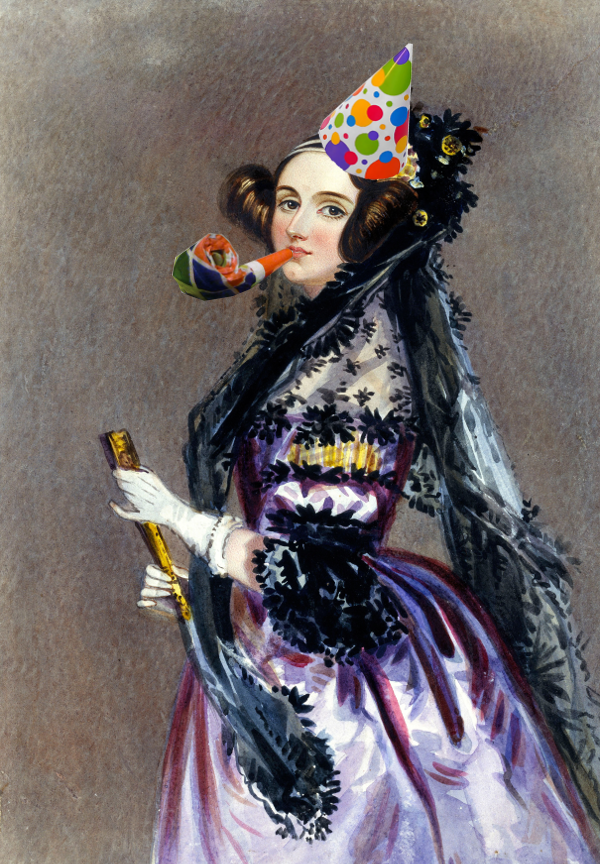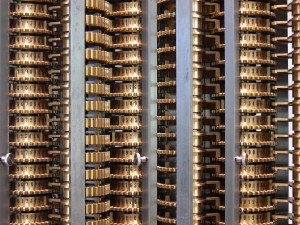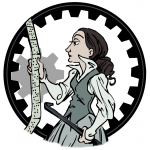
Today marks computing and maths pioneer Ada Lovelace’s 200th birthday. In celebration we’ve rounded up a few Ada-based links from around the internet.
Ada Lovelace was a 19th-century mathematician and early computer scientist, during an era when it was uncommon for women to do such things, and worked alongside Charles Babbage. His incredible Analytical Engine, an early mechanical calculator, was studied by Ada and her most enduring work is an article she wrote about the engine and its mathematical potential.

The Difference Engine which, though much less complicated, still looks pretty. Photo by Carsten Ullrich, CC-BY-SA-2.5 licensed.
Having watched Babbage speak about the engine in Italy in 1842, Italian mathematician Luigi Menabrea wrote a short description of the Analytical Engine and its possibilities, and Lovelace was asked to translate it into English, and add her own thoughts – which ended up being twice as long as the original piece, and included ideas about potential ways to ‘program’ the engine – in essence, the first example of computer code. The full text of Ada’s translation and article is an interesting read, and outlines the way the computer works, and the types of calculations it could potentially do.
Ada’s notes contained a program to compute the Bernoulli numbers. If you’re wondering how exactly that program worked, Rainer Glaschick has written a very in-depth explanation of how it’s done.
The Analytical Engine was a clockwork machine similar in construction to a weaving loom, and would have used punchcards to input data – many advanced weaving looms of the day had punchcard-based systems for inputting textile patterns. Our own CLP, always up for a challenge, has written an interactive punchcard simulator, which you can use to try creating messages in binary – screenshots on a tshirt please, team nerds.
Here’s a collection of other interesting Lovelace links:
 Ada Lovelace has sort of become the figurehead for efforts to promote women in STEM. The Finding Ada campaign celebrates Ada Lovelace Day each October by organising events jam-packed with STEMmy role models, and has a hugely informative website full of background and articles, including a great biography of Ada Lovelace, and information about the events taking place each October all over the world.
Ada Lovelace has sort of become the figurehead for efforts to promote women in STEM. The Finding Ada campaign celebrates Ada Lovelace Day each October by organising events jam-packed with STEMmy role models, and has a hugely informative website full of background and articles, including a great biography of Ada Lovelace, and information about the events taking place each October all over the world.
Other laudable efforts to promote women in STEM include ScienceGrrl, Girl Geek Dinners, and STEMettes.
Sydney Padua is a comic book artist and author, who’s written a series of graphic novels on The Adventures of Lovelace and Babbage – available as a book, and with alternate-universe versions of Ada as well as realistic historical ones. She’s posted these lovely animated GIFs to celebrate the day, and has also been tweeting from the Oxford Ada Lovelace Symposium they held yesterday to celebrate Lovelace’s 200th. The livestream of that symposium is available to watch again, since it’s a bit late to watch it live.
Awww! Ada Lovelace's cat, as drawn by her mother. #LovelaceOxford pic.twitter.com/wjQxJ8wnoS
— Terence Eden is on Mastodon (@edent) December 9, 2015
Computer Science For Fun (CS4FN), based at Queen Mary University, have a regular magazine and this month’s is a Lovelace special – it’s downloadable as a PDF from their website, and includes interesting facts about Ada’s life, and some fun related activities.
A recent BBC documentary fronted by Aperiodicrush Hannah Fry was titled Calculating Ada: the Countess of Computing, and while it’s not available on iPlayer in its entirety any more, the BBC programme page does have some links to interesting related articles and clips from the show. Hannah Fry also narrated a BBC Radio 4 documentary called Computing Britain, about the history of computing since the 1940s.
You can watch this animated biography of Ada Lovelace, narrated by Hannah Fry and illustrated by Sydney Padua:
https://www.youtube.com/watch?v=FQ7FcNWBc20&feature=youtu.be
YouTube contains hundreds of other excellent Lovelace videos – to pick one at random, Brady Haran, of Numberphile fame, has another channel Sixty Symbols (think: Physics-and-astronomy-phile), which has a video about Ada Lovelace’s tomb.
If that’s a bit too visual, you can listen to the Oxford Dictionary of National Biography has released this audio biography of Ada:
https://soundcloud.com/odnb/ada-lovelace
 A while ago, we posted about an idea for a Lovelace and Babbage LEGO set that needed support. It’s now about halfway to its target – if you like the idea of owning some tiny plastic mathematicians, maybe go and support it on LEGO Ideas.
A while ago, we posted about an idea for a Lovelace and Babbage LEGO set that needed support. It’s now about halfway to its target – if you like the idea of owning some tiny plastic mathematicians, maybe go and support it on LEGO Ideas.
The Science Museum in London is hosting an Ada Lovelace exhibition, until the end of March 2016. There’s some information about what they’ve got – including their replica of the Difference Engine – on the Science Museum blog.
Finally, you can keep up with all the day’s activities by watching the #AdaLovelace hashtag. The tweet below is a particularly fine example of what you’ll find there:
. へ)て彡乀ミ
.ー〜の/ア())༴彡、
/三三三三三\()イ༴)
彡(ー-、 ,-ー((ミ彡))
(彡)<ō>)١<ō>~)ミ彡)/
'\(- /_ (ミ/
~ ١ .-,-_
\ `乛 /
` ー#AdaLovelace born #OTD— Katya ᷅_(ヅ)_/ ᷄ (@kpcuk) December 10, 2015